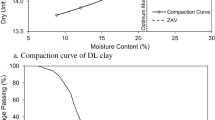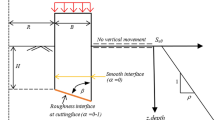Abstract
An isotropic hardening elastoplastic model for soil is presented, which takes into consideration the influence of structure and overconsolidation on strength and deformation of clays. Based on the superloading concept and subloading concept, the inner structural variable ω and overconsolidation variable ρ are introduced to describe the structure and overconsolidation of soil. The present model requires three additional parameters which can be obtained by conventional triaxial test, and the other parameters are same as those of modified Cam-clay (MCC) model. The performance of the proposed model is verified by undrained and drained triaxial tests.
Similar content being viewed by others
References
ZHU H H, YE B, CAI Y C, et al. An elasto-viscoplastic model for soft rock around tunnels considering overconsolidation and structure effects [J]. Computers and Geotechnics, 2013, 50: 6–16.
LI M G, ZHANG Z J, CHEN J J, et al. Zoned and staged construction of an underground complex in Shanghai soft clay [J]. Tunnelling and Underground Space Technology, 2017, 67: 187–200.
LI M G, CHEN J J, WANG J H, et al. Comparative study of construction methods for deep excavations above shield tunnels [J]. Tunnelling and Underground Space Technology, 2018, 71: 329–339.
YE B, YE G L, ZHANG F, YASHIMA A. Experiment and numerical simulation of repeated liquefactionconsolidation of sand [J]. Soils and Foundations, 2007, 47(3): 547–558.
YAO Y P, HOU W, ZHOU A N. UH model: Threedimensional unified hardening model for overconsolidated clays [J]. Géotechnique, 2009, 59(5): 451–469.
YIN Z Y, KARSTUNEN M, CHANG C S, et al. Modeling time-dependent behavior of soft sensitive clay [J]. Journal of Geotechnical and Geoenvironmental Engineering, 2011, 137(11): 1103–1113.
SUN D A, ZHANG J R, GAO Y, et al. Influence of suction history on hydraulic and stress-strain behavior of unsaturated soils [J]. International Journal of Geomechanics, 2016, 16(6): D4015001.
WHITTLE A J, KAVVADAS M J. Formulation of MIT-E3 constitutive model for overconsolidated clays [J]. Journal of Geotechnical Engineering, 1994, 120(1): 173–198.
HASHIGUCHI K, CHEN Z P. Elastoplastic constitutive equation of soils with the subloading surface and rotational hardening [J]. International Journal for Numerical and Analytical Methods in Geomechanics, 1998, 22(3): 197–227.
NAKAI T, HINOKIO M. A simple elastoplastic model for normally and overconsolidated soils with unified material parameters [J]. Soils and Foundations, 2004, 44(2): 53–70.
KAVVADAS M, AMOROSI A. A constitutive model for structured soils[J]. Géotechnique, 2000, 50(3): 263–273.
LIU M D, CARTER J P. Modelling the destructuring of soils during virgin compression [J]. Géotechnique, 2000, 50(4): 479–483.
LIUM D, CARTER J P. A structured Cam Clay model [J]. Canadian Geotechnical Journal, 2002, 39(6): 1313–1332.
ZHU E Y, YAO Y P. Structured UH model for clays[J]. Transportation Geotechnics, 2015, 3: 68–79.
ASAOKA A, NAKANO M, NODA T. Superloading yield surface concept for highly structured soil behavior[ J]. Soils and Foundations, 2000, 40(2): 99–110.
ASAOKA A, NAKANO M, NODA T, et al. Delayed compression/consolidation of natural clay due to degradation of soil structure [J]. Soils and Foundations, 2000, 40(3): 75–85.
ROSCOE K H, SCHOFIELD A N, THURAIRAJAH A. Yielding of clays in states wetter than critical [J]. Géotechnique, 1963, 13(3): 211–240.
MATSUOKA H, NAKAI T. Stress-deformation and strength characteristics of soil under three different principal stresses [J]. Proceedings of the Japan Society of Civil Engineers, 1974, 232(9): 59–70.
YAO Y P, SUN D A. Application of Lade’s criterion to Cam-clay model [J]. Journal of Engineering Mechanics, 2000, 126(1): 112–119.
YAO Y P, ZHOU A N, LU D C. Extended transformed stress space for geomaterials and its application [J]. Journal of Engineering Mechanics, 2007, 133(10): 1115–1123.
BECKER D E, CROOKS J H A, BEEN K, et al. Work as a criterion for determining in situ and yield stresses in clays [J]. Canadian Geotechnical Journal, 1987, 24(4): 549–564.
YE G L, YE B. Investigation of the overconsolidation and structural behavior of Shanghai clays by element testing and constitutive modeling [J]. Underground Space, 2016, 1(1): 62–77.
YE G L, YE B, ZHANG F. Strength and dilatancy of overconsolidated clay in drained true triaxial tests [J]. Journal of Geotechnical and Geoenvironmental Engineering, 2014, 140(4): 06013006.
Author information
Authors and Affiliations
Corresponding author
Additional information
Foundation item: the National Natural Science Foundation of China (No. 41602282)
Rights and permissions
About this article
Cite this article
Zhang, S., Liao, C., Zhang, Q. et al. Elastoplastic Model for Soils Considering Structure and Overconsolidation. J. Shanghai Jiaotong Univ. (Sci.) 24, 196–203 (2019). https://doi.org/10.1007/s12204-019-2050-1
Received:
Published:
Issue Date:
DOI: https://doi.org/10.1007/s12204-019-2050-1




